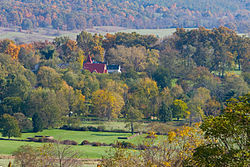Paris, Virginia
| Paris, Virginia | |
|---|---|
| Unincorporated Village | |

Paris in autumn (Trinity United Methodist Church with Ashby Inn behind it)
|
|
| Location within the Commonwealth of Virginia | |
| Coordinates: 39°00′16″N 77°57′05″W / 39.00444°N 77.95139°WCoordinates: 39°00′16″N 77°57′05″W / 39.00444°N 77.95139°W | |
| Country | United States |
| State | Virginia |
| County | Fauquier |
| Time zone | Eastern (EST) (UTC-5) |
| • Summer (DST) | EDT (UTC-4) |
| ZIP codes | 20130 |
| FIPS code | 061 |
| GNIS feature ID | 1493393 |
Paris is now a small unincorporated community in Fauquier County, Virginia, United States. Located in Virginia's hunt country, it was established in a strategic spot at the eastern base of Ashby Gap along U.S. Route 17 and U.S. Route 50. Paris has a population of 51.
Peter Glascock acquired the deed for what became the town in 1786 from Thomas Lord Fairfax, since it had been part of his Leeds Manor. Kimball Hicks had operated a tavern nearby since 1782, and Glascock also operated a similar venture, both of which were sometimes cited for failure to adhere to the terms of their licenses. A post office existed by 1800. The Virginia General Assembly in 1810 issued a charter for a town at the intersection of Ashby Gap Road (which it authorized to be paved that year, and later became Route 50) and the Dumfries-Winchester Road (which later became Route 17), although the town was actually platted two decades earlier (and not all of the 14 planned streets were ever completed). In 1819 the town was named to memorialize the tour of the returning Marquis de Lafayette to the United States after the War of 1812. No written account explains why the place was not directly named after the Marquis, although Peter Glascock served in the Revolutionary army and greatly admired him.
The market town prospered in the early 19th century (with a population of 200 in 1835), but lagged in the middle of the century because none of the newly constructed railroads went through it. It was last listed as an incorporated town in 1830. In 1835, Paris had several taverns, three stores, a school and a church shared by several denominations, as well as 25 dwellings, 2 saddlers, 2 blacksmiths, 2 wagonmakers, a tailor, a cabinetmaker, a chairmaker, a turner, a wheat fan maker and three boot and shoe factories.
The Manassas Gap Railroad constructed in 1852 went slightly south, through nearby Marshall, Delaplane and The Plains, Virginia, so Paris and its carting-based businesses declined. Because of its distance from the rail lines, the town saw little conflict during the American Civil War, and was referred to in disparaging terms by both Confederate and Union writers. The population in 1880 was 134 persons in 22 households, including physicians, wheelwrights, blacksmiths, harness makers, tanners, shoemakers, carpenters, seamstresses and a bookkeeper and silversmith. The current Routes 17 and 50 were slightly rerouted outside the historic town (Ashby Gap turnpike was once the town's main street, and the old Ashby Hotel/tavern was destroyed in 1939 by a runaway truck coming down from the mountain).
...
Wikipedia



